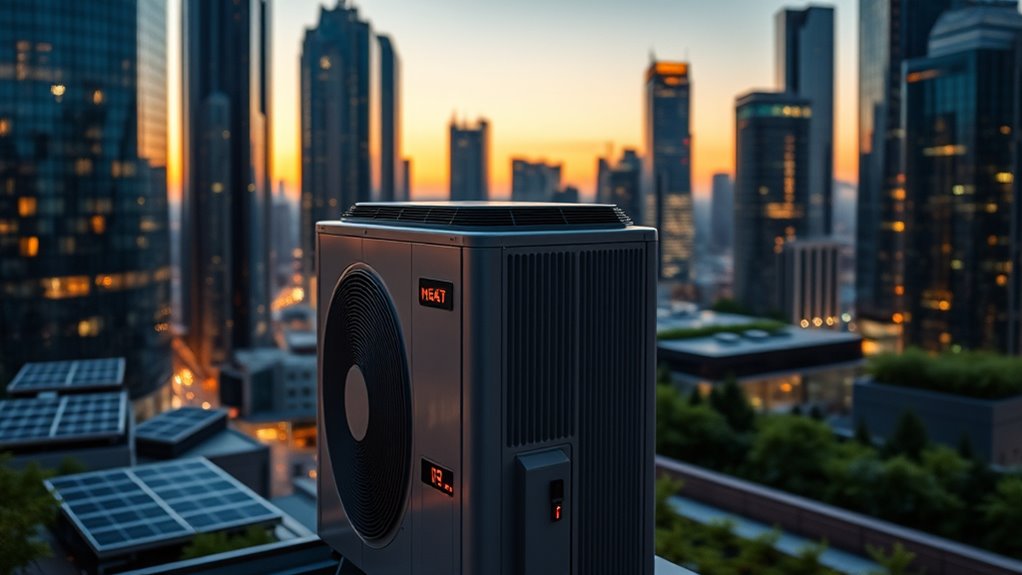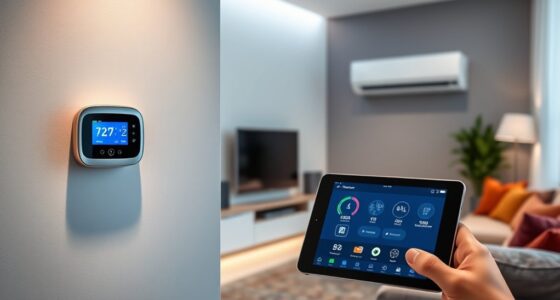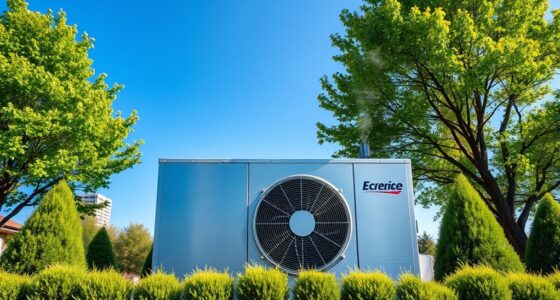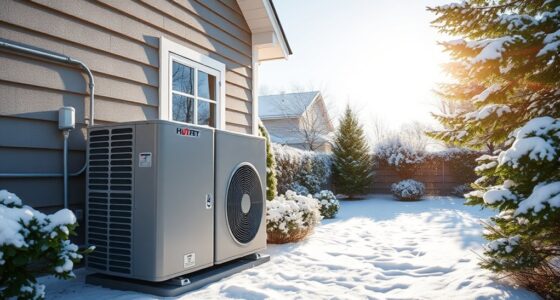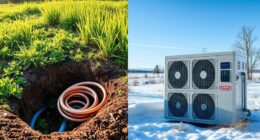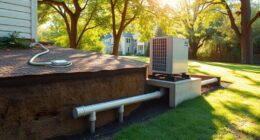Heat pumps play a crucial role in smart cities by providing efficient, sustainable heating and cooling that help lower energy use and reduce emissions. They can be integrated into urban infrastructure, like foundation systems and district networks, to maximize space efficiency and optimize climate control. Advances in geothermal systems, energy modeling, and smart technology make heat pumps adaptable to city needs. Continuing to explore this topic reveals how these systems drive innovation in urban sustainability.
Key Takeaways
- Heat pumps provide efficient heating and cooling, reducing urban heat island effects and improving indoor climate control in smart cities.
- Integration of geothermal heat pumps with urban infrastructure optimizes district-level climate regulation and space-efficient energy solutions.
- AI-enabled control systems and smart grids enhance heat pump operation, increasing energy efficiency and responsiveness in urban environments.
- Embedding energy piles with heat exchangers supports sustainable foundation systems, leveraging underground temperature stability for energy savings.
- Incentives and policies promote heat pump adoption, helping smart cities achieve lower emissions and enhance sustainable urban development.
How Heat Pumps Enhance Urban Climate Control

Heat pumps substantially improve urban climate control by providing efficient heating and cooling solutions that reduce reliance on fossil fuels. Geothermal heat pumps, a type of ground-source heat pump, leverage stable underground temperatures for consistent thermal energy storage and heat exchange, enhancing energy efficiency. In smart cities, these systems integrate seamlessly with urban infrastructure, optimizing climate regulation across districts. By utilizing thermal energy storage and inverter-driven compressors, heat pumps boost efficiency by up to 30%, helping combat urban heat island effects. Their ability to adapt to outdoor conditions ensures reliable indoor climate control. Additionally, the integration of wave and wind energy sources can further power heat pump systems sustainably, reducing environmental impact. The renewable energy sources used in conjunction with heat pumps contribute to a significant reduction in greenhouse gas emissions. Furthermore, advancements in smart grid technology facilitate better management of energy distribution, making heat pump systems even more effective within urban environments. Incorporating energy storage solutions can further enhance system reliability and efficiency. Moreover, the use of natural materials in the construction of heat pump components can improve durability and sustainability. As a result, heat pumps play an essential role in carbon reduction efforts, making city environments more sustainable while supporting smarter, greener urban development.
The Integration of Ground Source Heat Pumps in City Infrastructure
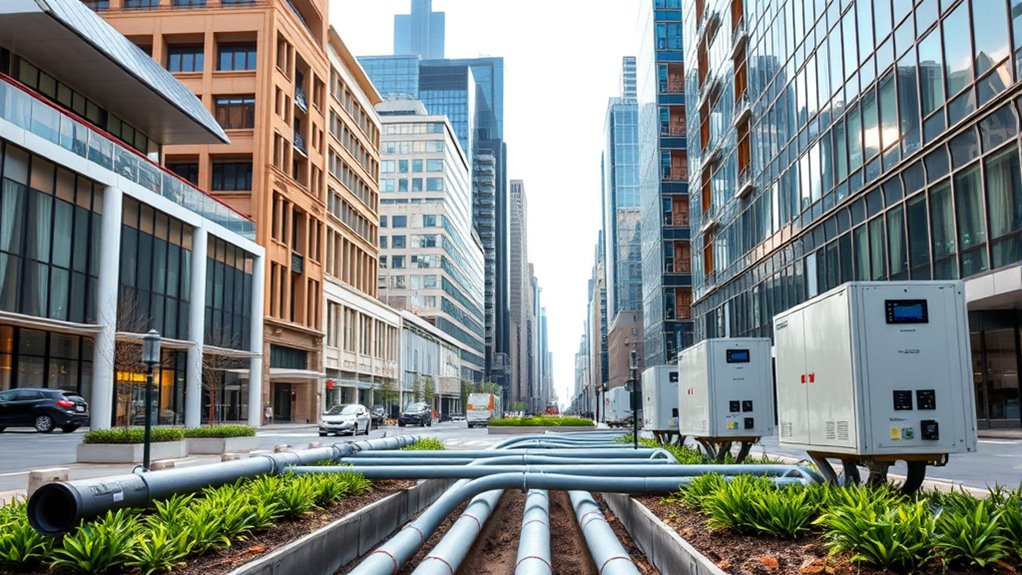
Integrating ground source heat pumps into city infrastructure offers a smart and space-efficient way to enhance urban climate management. By embedding GSHPs into foundation systems like energy piles, you combine structural support with thermal exchange, maximizing space use. These geothermal systems leverage the stable underground temperature to provide efficient heating and cooling, reducing energy costs and lowering carbon emissions. In dense urban areas, energy piles can be installed within existing or new buildings, minimizing the need for additional geothermal boreholes. The thermal performance of these foundation systems depends on soil characteristics and groundwater flow, influencing heat transfer efficiency. Additionally, soil properties play a crucial role in optimizing geothermal energy extraction and storage in such applications. Proper assessment of soil thermal conductivity is essential for designing effective geothermal systems in urban settings. Advances in geothermal technology continue to improve the performance and reliability of these systems, making them more viable for large-scale urban deployment. As urban populations grow, the integration of geothermal solutions like energy piles becomes increasingly important for sustainable development and urban energy efficiency. This integration supports smart city development by boosting energy efficiency and resilience against urban heat island effects. Additionally, cost considerations can influence the feasibility of implementing such geothermal solutions in large-scale urban projects.
Design and Functionality of Energy Piles as Dual-Purpose Systems
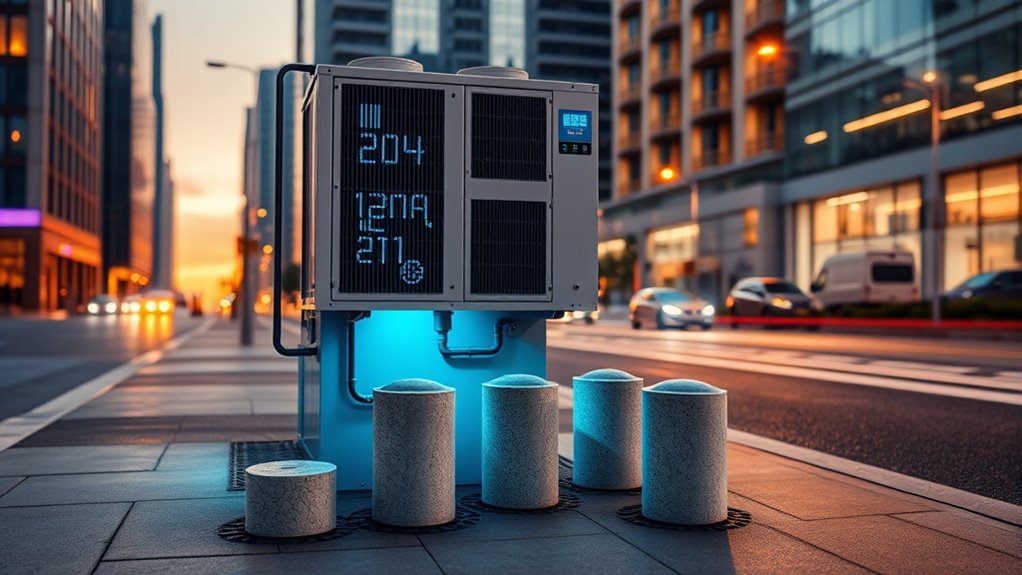
Energy piles combine structural support with thermal energy exchange, making them a smart choice for urban infrastructure. Their design optimizes heat transfer by considering soil properties, borehole depth, and groundwater flow. Tailoring energy piles to specific sites enhances efficiency and supports sustainable city development. Additionally, integrating automation technologies into their construction and monitoring can further improve performance and maintenance. Incorporating Kia Tuning techniques into the design process can also contribute to more resilient and adaptable urban systems. Recognizing the importance of contrast ratio in visual systems can aid in designing more effective monitoring displays for these systems. For example, understanding support hours for related services can streamline maintenance and operational planning.
Structural Support Integration
Structural support integration in smart cities involves designing foundations that serve a dual purpose: supporting buildings and facilitating geothermal heat transfer. Energy piles are reinforced concrete foundations embedded with heat exchangers, combining foundation support with geothermal energy functions. During construction, U-shaped or coil-shaped pipes are embedded within the concrete, enabling efficient heat exchange with the ground. The success of these systems depends on geotechnical factors like soil thermal conductivity and groundwater flow, which influence heat transfer efficiency and longevity. By integrating heat exchangers directly into foundation supports, energy piles reduce installation costs and space requirements, making them ideal for urban environments. This dual-functionality ensures robust structural support while optimizing ground source heat pump performance in dense settings. Additionally, proper design considerations can enhance the durability of energy piles, ensuring long-term performance in varying soil conditions.
Heat Exchange Optimization
How can the design of energy piles maximize their dual role as structural supports and efficient heat exchangers? By optimizing their configuration for thermal transfer, you enhance the performance of ground source heat pumps. Energy piles incorporate embedded pipe loops that facilitate heat exchange between the geothermal environment and the building’s heating or cooling system. Effective heat transfer mechanisms, such as conduction through soil particles and convection within pore water, are influenced by material choice and site-specific geotechnical properties. To achieve system optimization, you should consider factors like pile depth, soil permeability, and groundwater circulation. These elements ensure consistent thermal transfer, maintaining stable underground temperatures around 55°F and boosting the efficiency of the heat exchanger, ultimately reducing operational costs and maximizing energy performance. Additionally, understanding vacuum technology can improve the insulation and sealing of pipe loops, further enhancing heat transfer efficiency. Incorporating geotechnical data into the design process can also help tailor the system to specific site conditions, ensuring optimal performance and longevity. Moreover, leveraging advancements in AI entertainment can assist in simulating various design scenarios, optimizing configurations before deployment. Recognizing the importance of soil characteristics can lead to better material selection and system durability, ensuring reliable operation over time. Furthermore, integrating creative problem-solving approaches can help address unforeseen challenges during installation or operation, making the system more resilient and adaptable to changing environments.
Site-Specific Design
Designing energy piles to function effectively as both structural supports and heat exchangers requires tailoring their features to the specific site conditions. You must consider geotechnical engineering factors, including soil properties like type, density, and moisture content, which influence heat transfer efficiency. Thermal modeling helps predict ground temperature profiles and optimize heat exchanger placement within the energy pile. Site-specific design involves customizing grout materials and borehole layout to enhance thermal conductivity while maintaining structural integrity. You should evaluate regional climate data and groundwater flow, as these affect heat exchange dynamics. Additionally, understanding vape juice shelf life and storage conditions can inform the selection of materials and design features to prevent spoilage and ensure durability. Incorporating Honda Tuning principles, such as tailored modifications, can further improve the performance and efficiency of energy piles in various environments. Staying informed about energy efficiency standards and advancements in sustainable design can guide the development of more effective and eco-friendly solutions. Moreover, considering installation techniques can significantly influence the long-term performance and reliability of the system. By integrating these considerations, your energy piles can provide efficient heating and cooling solutions, seamlessly supporting urban infrastructure and adapting to local geological and climate conditions.
Geotechnical and Thermal Properties Affecting Heat Pump Efficiency
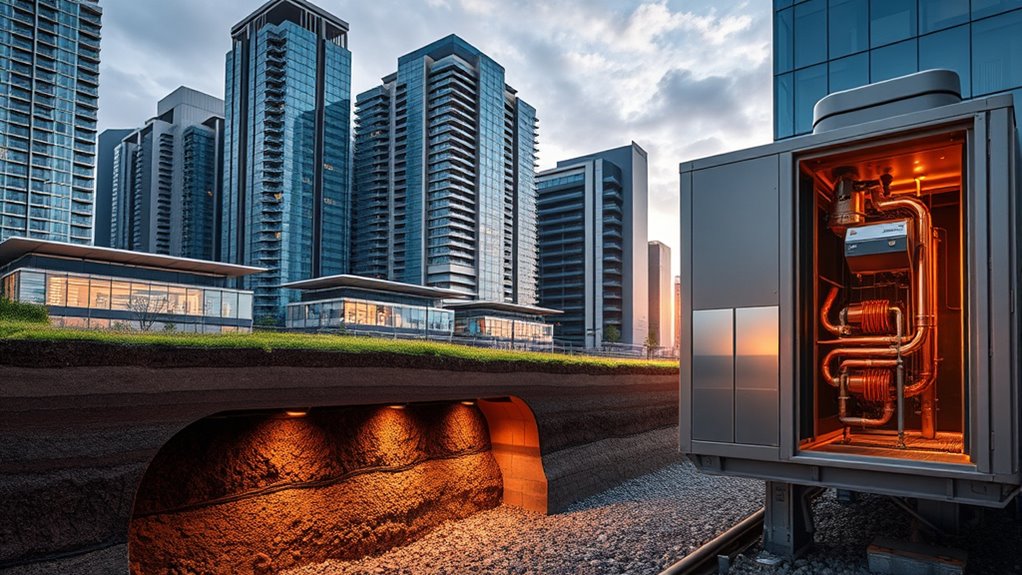
Understanding soil thermal conductivity is key because it varies with mineral composition, porosity, and water content, directly impacting heat transfer efficiency. Ground temperature stability influences how well geothermal systems perform year-round, especially in urban areas with changing climates. Recognizing how porosity and water content affect thermal properties helps optimize heat pump design for different geotechnical conditions. Additionally, knowledge of ground temperature regulation can assist in predicting seasonal performance variations of geothermal systems. Recent advances in machine learning algorithms also enable more accurate modeling of subsurface thermal behaviors, further improving system efficiency.
Soil Thermal Conductivity Variability
Soil thermal conductivity in urban environments varies widely due to differences in mineral composition, porosity, and moisture content. These variations influence the thermal properties that affect heat transfer efficiency in ground source heat pumps and geothermal heat exchange systems. Urban soils with high pore water content, for example, often have higher thermal conductivity, improving energy pile performance. Site-specific measurements of geotechnical properties are essential to accurately assess these variations and optimize system design. Factors influencing soil thermal conductivity include:
- Mineral composition and porosity
- Moisture content levels
- Soil type, such as clay versus sand
- Urban soil disturbance and compaction
- Changes in geotechnical properties over time
Understanding these factors helps guarantee efficient heat transfer and system reliability.
Ground Temperature Stability
Ground temperature stability plays a crucial role in the efficiency of geothermal heat pump systems, especially in urban environments. Underground temperatures at depths of 9–12 meters remain relatively stable year-round, offering a reliable thermal source for ground source heat pumps. Soil thermal properties, such as heat capacity and conductivity, influence geothermal heat exchange efficiency, with higher conductivity improving heat transfer. Seasonal temperature fluctuations lag behind surface air temperatures, ensuring underground temperatures stay consistent despite surface variations. Urban heat island effects can raise ground temperatures by about 2°C, affecting thermal stability and energy pile system performance. Maintaining stable ground temperatures is essential for maximizing geothermal heat pump efficiency, as it ensures consistent underground temperatures that support optimal heat exchange throughout the year.
Porosity and Water Content
Porosity and water content are critical factors that directly influence the thermal performance of geothermal heat pump systems. High porosity indicates more void spaces, which can decrease thermal conductivity but increase soil saturation, affecting heat transfer efficiency. When water content increases, soils become better conductors of heat, boosting geothermal energy extraction. Variations in these properties alter thermal diffusivity, impacting how quickly heat moves through geotechnical materials. Low porosity and minimal water saturation typically reduce thermal conductivity, limiting heat exchange. To optimize energy piles and geothermal systems, you must carefully assess porosity and water content, as these factors determine soil saturation, thermal conductivity, and overall system efficiency. Proper evaluation ensures reliable, efficient heat pump operation within diverse geotechnical conditions.
Modeling Ground Temperatures and Heat Transfer Dynamics
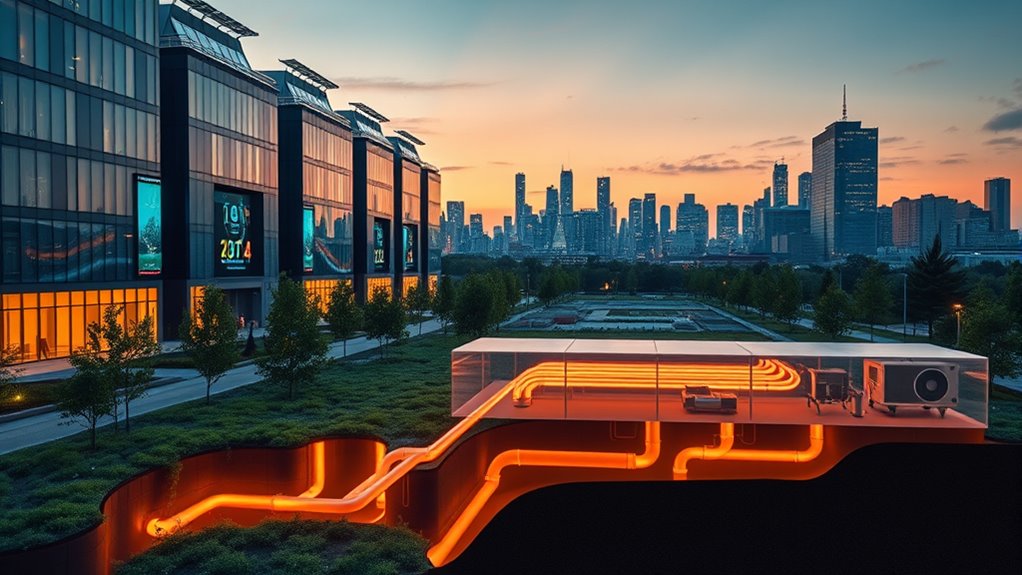
Modeling ground temperatures and heat transfer dynamics involves analyzing how thermal energy moves through subsurface materials over time. You consider ground temperature stability at depths of 9–12 meters, where it remains around 17–24°C, offering a reliable heat source or sink. Seasonal surface air temperature changes lag behind subsurface temperature dynamics, influenced by soil properties and depth. Heat transfer occurs via conduction through mineral particles and convection through pore water, both affected by geomaterials and soil saturation. Thermal modeling uses finite element or finite difference methods to simulate transient and steady-state heat transfer, incorporating boundary conditions shaped by environmental factors. Urbanization can raise ground temperatures by about 2°C, impacting geothermal system efficiency and requiring precise modeling of temperature dynamics for ideal heat pump performance.
Economic Benefits and Incentives for Urban Heat Pump Adoption

Have you considered how financial incentives can make urban heat pump adoption more accessible? Tax incentives like the Investment Tax Credit can cover up to 30% of installation costs, easing initial expenses. State and local rebates, grants, and subsidies further encourage energy efficiency upgrades in cities. Using innovative investment models, such as third-party ownership or power purchase agreements, reduces upfront costs and boosts ROI. These incentives offer benefits like lower utility bills, improved building certifications, and compliance with energy standards. Government policies are set to accelerate urban heat pump adoption, supporting cost savings and reducing carbon emissions.
- Tax incentives lowering upfront costs
- Rebates and grants boosting affordability
- Investment models easing financial barriers
- Cost savings through energy efficiency
- Policies promoting sustainable urban infrastructure
Overcoming Site Constraints and Regulatory Challenges
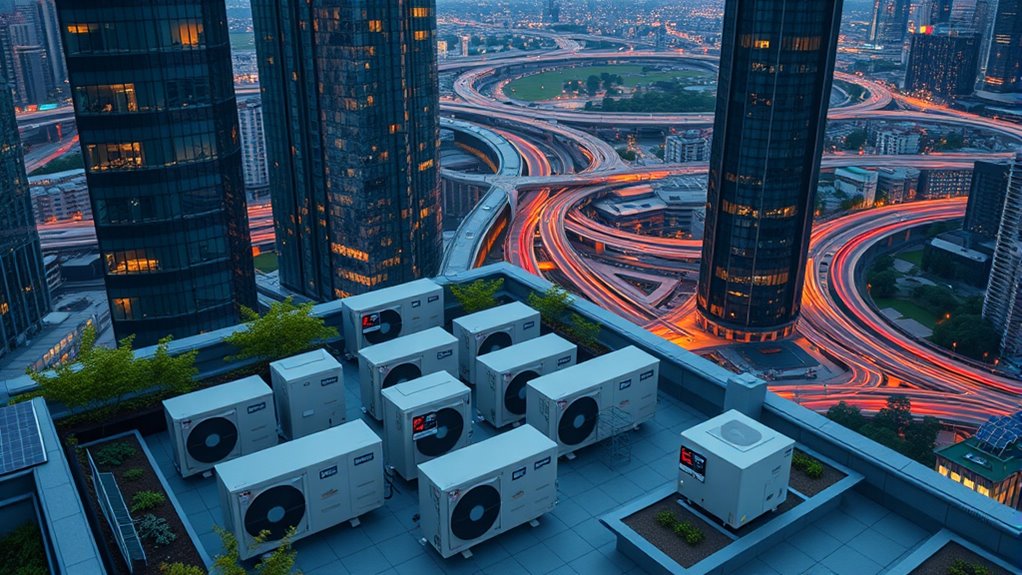
Overcoming site constraints and regulatory challenges is essential for successful urban heat pump deployment. Limited ground space or existing urban infrastructure can be addressed by integrating energy piles into existing foundations, enabling geothermal heat exchange without extra land use. Zoning restrictions and building codes often require permits and strict adherence to safety standards, making regulatory compliance vital. Urban underground utility networks and transportation systems complicate geothermal installation, requiring detailed geotechnical surveys and close coordination with city planners. Innovative trenchless drilling techniques and adaptive system designs help navigate these site constraints while maintaining safety and environmental standards. Additionally, incentive programs and subsidies, like tax credits and local grants, can offset high initial costs, easing the regulatory and logistical hurdles involved in urban geothermal projects.
Environmental Impact and Sustainability of Heat Pump Systems
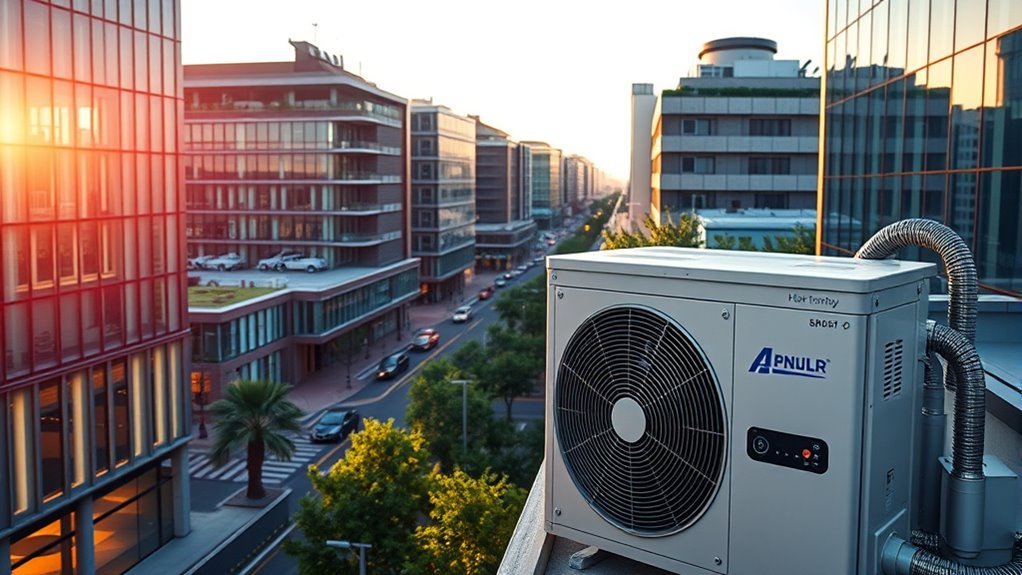
Heat pump systems play a crucial role in advancing the environmental sustainability of smart cities by considerably reducing carbon emissions. By replacing fossil fuel-based heating and cooling, many models achieve up to 50% lower lifecycle emissions. Integrating heat pump systems with renewable energy sources like solar and wind boosts overall sustainability and helps meet climate goals. Ground source heat pumps in urban environments further decrease reliance on grid electricity, lowering carbon footprints. Advanced inverter-driven technologies enhance efficiency and reduce energy consumption, supporting greener cities. Widespread adoption promotes decarbonization efforts and moves buildings toward net-zero emissions.
- Reduce reliance on fossil fuels
- Enhance efficiency with smart technology
- Use renewable energy sources
- Lower carbon footprint in urban areas
- Support net-zero emissions goals
Future Trends and Innovations in Smart City Heating and Cooling
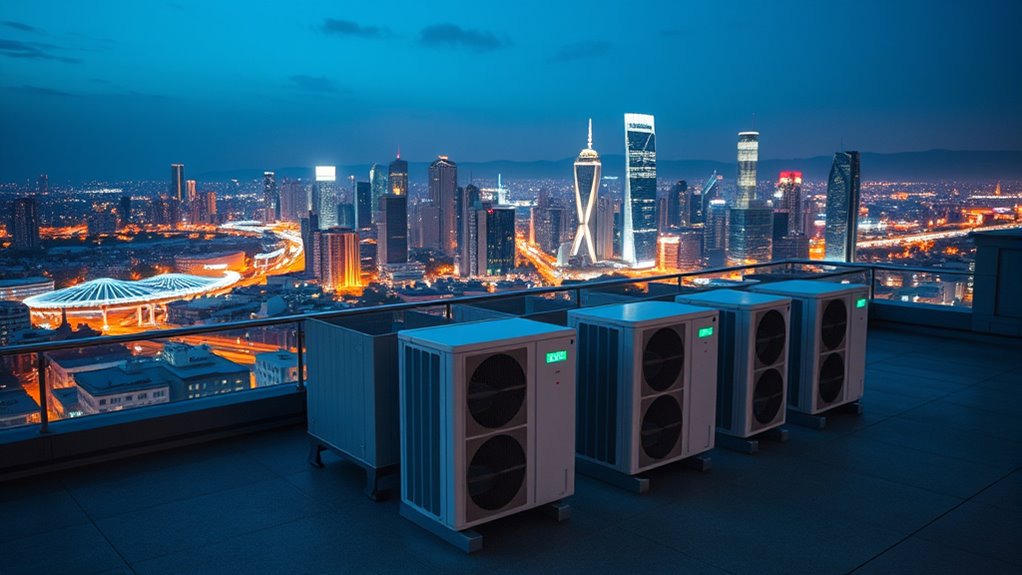
As smart cities continue to evolve, innovative trends are transforming heating and cooling systems to become more efficient and sustainable. Advances in heat pump technology, like inverter-driven heat pumps, boost smart city energy efficiency by adapting to fluctuating grid demands. AI-enabled control systems optimize operations, cutting energy use by up to 30%. Hybrid geothermal systems, combining energy piles with renewable sources, improve urban resilience and sustainability. High-temperature heat pumps now expand district heating applications, aiding decarbonization efforts across neighborhoods. Emerging materials and sensor technologies enhance heat pump durability and responsiveness, supporting widespread deployment. These innovations in innovative heating and cooling exemplify how smart city initiatives are driving sustainable urban thermal management and integrating renewable energy sources for a cleaner future.
Frequently Asked Questions
What Is the Function of a Heat Pump?
A heat pump’s main function is to transfer thermal energy between indoor and outdoor environments, providing heating or cooling as needed. You can think of it as a device that extracts heat from the outside air, ground, or water, then compresses and distributes it inside your building during winter, or removes heat during summer. Its reversible feature allows you to switch between heating and cooling modes easily, making your home comfortable year-round.
What Are the Benefits of a Heat Pump?
You benefit from heat pumps because they considerably cut your energy bills by up to 50%, replacing traditional systems. They use renewable heat sources, lowering your carbon footprint. With high efficiency and year-round climate control, you get reliable heating and cooling. Plus, with incentives and subsidies, installing one becomes more affordable, making your home more sustainable and cost-effective. Heat pumps truly support a greener, smarter way to manage your climate needs.
At What Temperature Is a Heat Pump Useless?
When temperatures dip below -20°F (-29°C), a heat pump often hits a wall, like a car stuck in snow. You might find it useless for heating in such extreme cold, needing supplementary systems to keep your home warm. While some high-efficiency models reach down to -5°F (-20°C), beyond that, your heat pump’s effectiveness fades fast, leaving you relying on alternative heating sources to battle winter’s harshest grip.
Does a Heat Pump Use More Electricity, Heating or Cooling?
You might wonder whether a heat pump uses more electricity heating or cooling. Generally, it consumes more energy during heating because it works harder to extract heat from cold outdoor air, especially in winter. In cooling mode, it uses less electricity, transferring heat from indoors to outside. The actual difference depends on your climate, system efficiency, and insulation, but heating typically demands more power than cooling.
Conclusion
By embracing heat pumps, you can considerably improve urban climate control while reducing energy costs. Did you know that heat pumps can cut greenhouse gas emissions by up to 50% compared to traditional systems? As cities grow smarter, integrating these systems not only boosts sustainability but also enhances residents’ comfort. So, investing in heat pump technology today can help you build a greener, more efficient future for your community.
